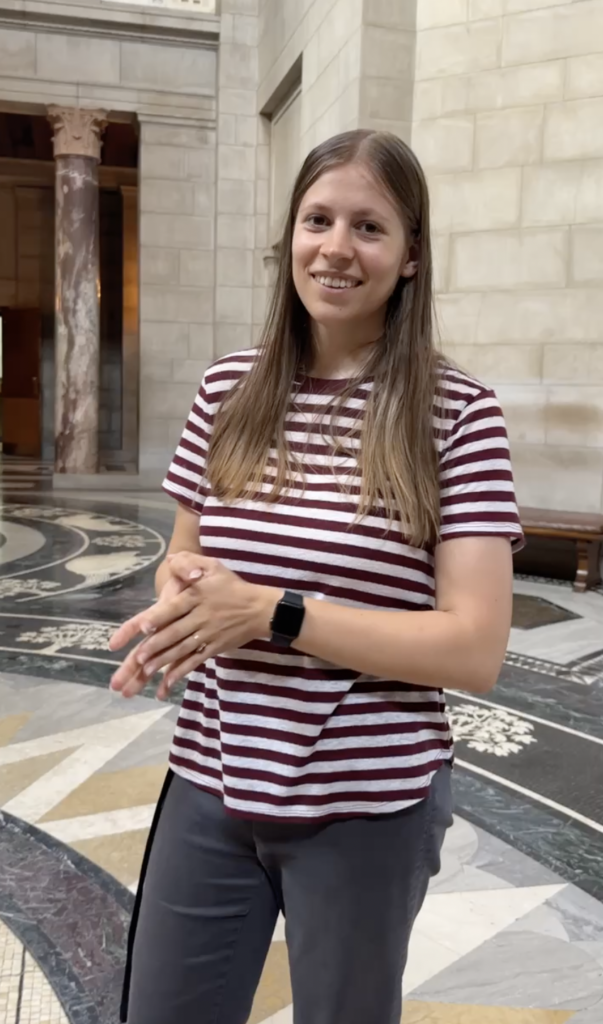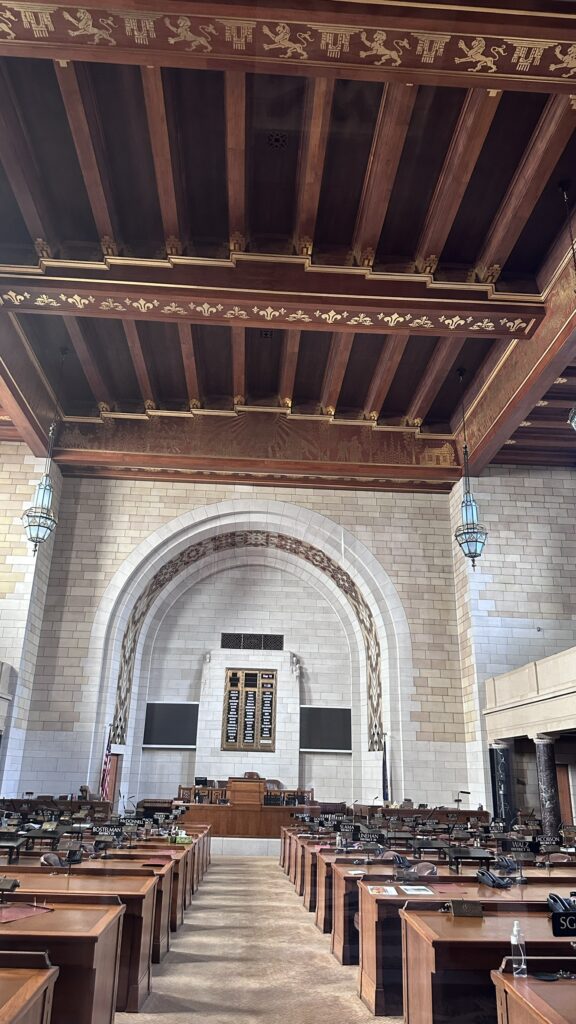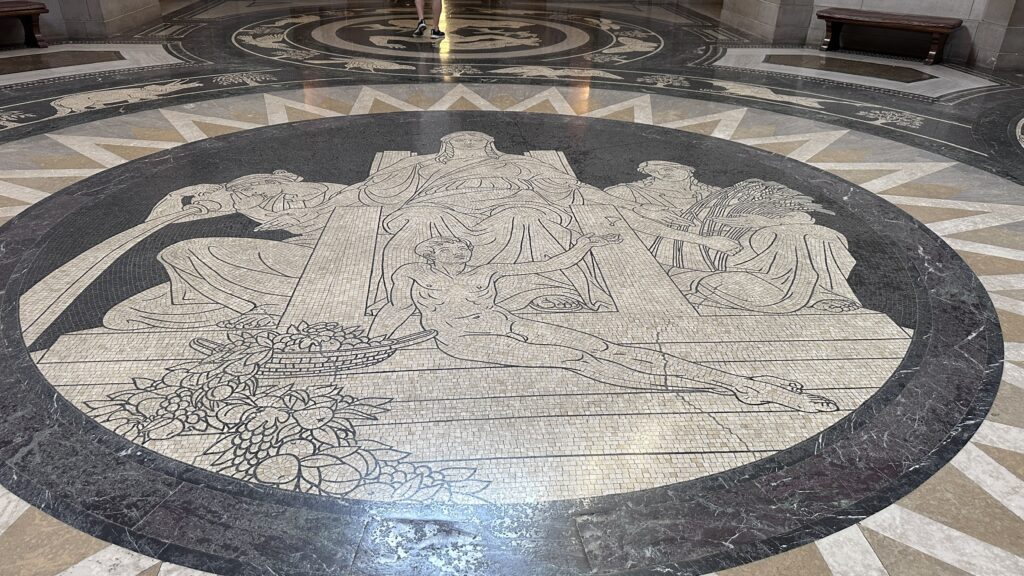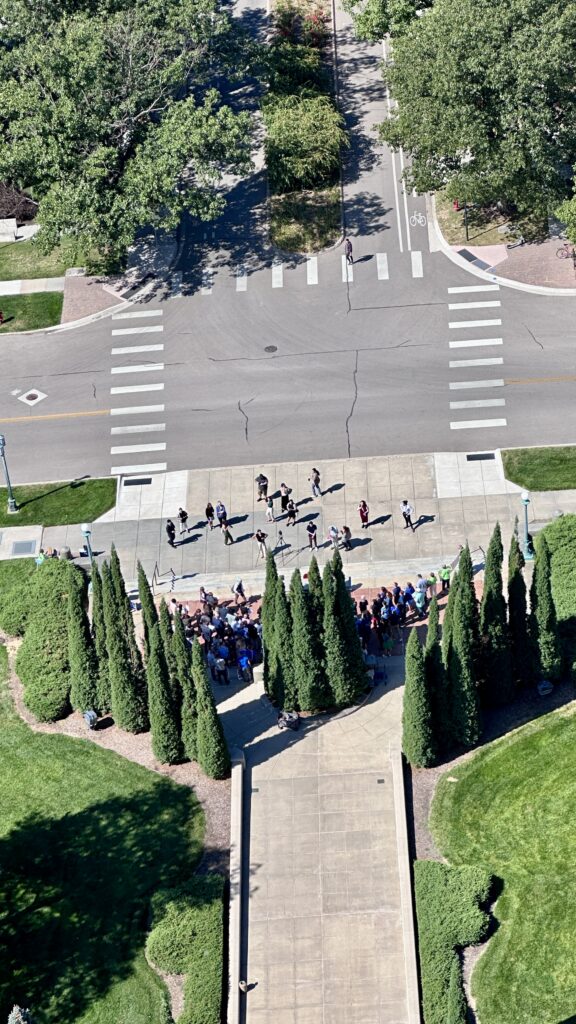
September 18, 2024. Lincoln Nebraska.

This is the first state to radically depart from the design of the U.S. Capitol and build a 400-foot tower. Built out of Indiana limestone, it is the second-tallest state capitol (only because Louisiana’s governor insisted theirs be taller).
They paid for the building as it was going up. Nebraska was not permitted to go into debt for the building of the Capitol, so much of the artwork had to be added later. The building cost just under $10 million when it was built in 1922-1932. If it were destroyed and needed to be rebuilt as it stands, it would cost into the billions.
The influences of Spain, France, and USA are noted in the artwork, representing some of the nations that made Nebraska great.
When we entered this state capitol, it felt a little weird at first. Like a catacomb. There was no grand entrance or visitor’s desk to greet us. We couldn’t see the dome, which we thought was strange as well. We didn’t realize we had entered through a back door.

We finally found the main entrance. It felt a bit overwhelming at first, as there are many mosaics on the ground and paintings in the main hallways; a tour guide noticed our confusion and asked if she could show us around. She had just finished with a group tour and had some time (I think she was feeling a little bored), so she gave us our own personal tour!
The Nebraska Capitol is one of the most unique buildings we have seen to date. We are still trying to decide whether we like the architectural decisions, which combines Egyptian style with Nebraskan landscape and history.

Fun Fact. Nebraska is the only unicameral state, meaning they don’t have a separate House and Senate. They haven’t always been that way. The bicameral, two-group system was based on British Parliament (House of Commons and House of Lords), which Senator George Norris believed should no longer apply to us. He believed the two-group allowed for too much blame, whereas one body would have to take full responsibility for decisions made. He proposed a new form of government, and Nebraska voted to move to a unicameral, one legislative chamber, in 1937. They meet in the old House of Representatives chamber pictured here. Notice the gold leaf painted on walnut wood, representing Spain (lions), France (flour de lis), and U.S. history (eagles).
I also found it interesting that a couple of young students created a ten-minute documentary on the history of Nebraska unicameral system, which is featured in their state website.
Brief video looking down on the floor of the rotunda. The tour guide explained this to us, but I can’t recall the detail. Wikipedia comes in handy at times. The Capitol has a number of these spectacular mosaics on the floor of the halls and rotunda.
“The Procession of Life continues in the Rotunda’s floor…At the Rotunda’s center, four tondi mosaics representing the Genius of Water, the Genius of Fire, the Genius of Air, and the Genius of Earth surround a larger tondo mosaic of Earth as the Life-giver.” (Wikipedia)
Surrounding each Genius are the animals found in Nebraska during archeological digs, or known to have lived in the water, air, earth, or died by fire.




Supreme Court. The very large tapestries on the Supreme Court walls are over 100 years old. Unfortunately they are faded by the Nebraska sun.
8,000 pieces of wood are used in the ceiling of this room, designed for acoustical purposes. Seven seats of justice are in front of a hidden door, where they enter and leave to their secret chambers.


Our tour guide walked us to the antique elevator, which took us up 14 floors to the four observation decks with views of the city. She stamped or passport and encouraged us to browse on our own from there.

The dome on top is octagonal shaped, and has large murals dedicated to various service personnel.


Our tour couldn’t be complete without a nod to The Lincoln Monument, built in 1912. This predates the current statehouse. The commission for the State Capitol stated, “Solutions should consider this monument and suggest for it a proper part in the ensemble, preferably but not imperatively on the building site proper.” Architects had to incorporate the Monument into their design proposals to be accepted.
The Lincoln Memorial in Washington D.C. was built a few years later (1914-1922).
It is also interesting to note, in 1976 the National Park Service designated the capitol a National Historic Landmark, and in 1997, the Park Service extended the designation to include the capitol grounds. We should have gotten a stamp in our NPS passport (darn).
À la prochaine…hasta la próxima vez…until next time!
